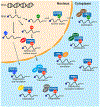Mechanisms of epitranscriptomic gene regulation
- PMID: 33001446
- PMCID: PMC7855325
- DOI: 10.1002/bip.23403
Mechanisms of epitranscriptomic gene regulation
Abstract
Chemical modifications on RNA can regulate fundamental biological processes. Recent efforts have illuminated the chemical diversity of posttranscriptional ("epitranscriptomic") modifications on eukaryotic messenger RNA and have begun to elucidate their biological roles. In this review, we discuss our current molecular understanding of epitranscriptomic RNA modifications and their effects on gene expression. In particular, we highlight the role of modifications in mediating RNA-protein interactions, RNA structure, and RNA-RNA base pairing, and how these macromolecular interactions control biological processes in the cell.
© 2020 Wiley Periodicals LLC.
Conflict of interest statement
CONFLICT OF INTEREST
No competing interests have been declared.
Figures




Similar articles
-
Epitranscriptomic influences on development and disease.Genome Biol. 2017 Oct 23;18(1):197. doi: 10.1186/s13059-017-1336-6. Genome Biol. 2017. PMID: 29061143 Free PMC article. Review.
-
The impact of epitranscriptomic marks on post-transcriptional regulation in plants.Brief Funct Genomics. 2021 Mar 27;20(2):113-124. doi: 10.1093/bfgp/elaa021. Brief Funct Genomics. 2021. PMID: 33274735 Review.
-
Nucleic Acid Modifications in Regulation of Gene Expression.Cell Chem Biol. 2016 Jan 21;23(1):74-85. doi: 10.1016/j.chembiol.2015.11.007. Cell Chem Biol. 2016. PMID: 26933737 Free PMC article. Review.
-
Dynamic RNA modifications in posttranscriptional regulation.Mol Cell. 2014 Oct 2;56(1):5-12. doi: 10.1016/j.molcel.2014.09.001. Mol Cell. 2014. PMID: 25280100 Free PMC article. Review.
-
Surpassing limits of static RNA modification analysis with dynamic NAIL-MS.Methods. 2019 Mar 1;156:91-101. doi: 10.1016/j.ymeth.2018.10.025. Epub 2018 Nov 3. Methods. 2019. PMID: 30395967
Cited by
-
Melatonin: Regulation of Biomolecular Condensates in Neurodegenerative Disorders.Antioxidants (Basel). 2021 Sep 17;10(9):1483. doi: 10.3390/antiox10091483. Antioxidants (Basel). 2021. PMID: 34573116 Free PMC article. Review.
-
The interplay between epitranscriptomic RNA modifications and neurodegenerative disorders: Mechanistic insights and potential therapeutic strategies.Ibrain. 2024 Nov 11;10(4):395-426. doi: 10.1002/ibra.12183. eCollection 2024 Winter. Ibrain. 2024. PMID: 39691424 Free PMC article. Review.
-
Metabolism of epigenetic ribonucleosides leads to nucleolar stress and cytotoxicity.bioRxiv [Preprint]. 2025 Jun 13:2025.06.11.659152. doi: 10.1101/2025.06.11.659152. bioRxiv. 2025. PMID: 40661430 Free PMC article. Preprint.
-
Evolutionary History of RNA Modifications at N6-Adenosine Originating from the R-M System in Eukaryotes and Prokaryotes.Biology (Basel). 2022 Jan 28;11(2):214. doi: 10.3390/biology11020214. Biology (Basel). 2022. PMID: 35205080 Free PMC article.
-
Melatonin: Regulation of Viral Phase Separation and Epitranscriptomics in Post-Acute Sequelae of COVID-19.Int J Mol Sci. 2022 Jul 23;23(15):8122. doi: 10.3390/ijms23158122. Int J Mol Sci. 2022. PMID: 35897696 Free PMC article. Review.
References
Publication types
MeSH terms
Substances
Grants and funding
LinkOut - more resources
Full Text Sources

